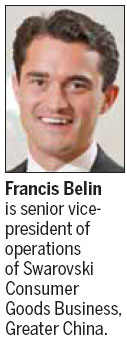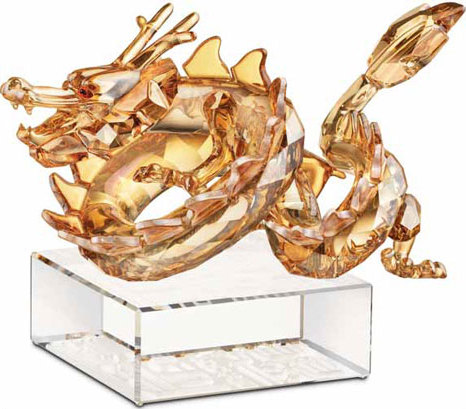Classic masterpieces
Updated: 2012-06-01 07:55
By Yang Yang (China Daily)
|
|||||||||
|
The crystal dragon is very popular this year, as the legendary animal is often associated with good luck. Provided to China Daily |
Swarovski aims for new impetus to luxury with Chinese collections
Inspired creations and imaginative figurines have always been promoted as unique selling propositions of Austrian crystal maker Swarovski, and perhaps why its collections are prized treasures for crystal collectors.
So it comes as no surprise that rich collectors in China are also making a beeline for Swarovski crystals, with the Chinese Zodiac range being the most popular.
With 2012 being the Year of the Dragon in China, there has been a rush among collectors to own crystal dragons, as the legendary animal is often associated with good luck and fortune in Chinese mythology.
"The Zodiac dragon is among the top 10 best-selling items in the Chinese mainland," says Francis Belin, senior vice-president of operations of Swarovski Consumer Goods Business, Greater China.
According to Belin, since 2009 the company has teamed up with the China Central Academy of Fine Arts to bring three zodiac animals to the Chinese market every year. This year, the three animals are the dragon, the monkey and the mouse.
Belin says that the collection has been designed and crafted specifically for Chinese consumers. With high-end Chinese consumers now being the big spenders in the global marketplace, the company plans to launch its "Kingdom of Jewels" collection in China later this year.
What will be different will be the distinctive Chinese elements like tassels and patterns of Chinese dragons in the new range of Swarovski jewelry and accessories, he says.

Although Swarovski prides itself as a company with a uniform product range, the incorporation of Chinese elements was necessary.
The mainland market, which Swarovski entered 17 years ago, is its second-largest single market after the United States.
China is likely to overtake the US as the company's main market in the next two years, Belin says.
From 2000 to 2010, the mainland market has been growing at an average annual rate of 26 percent, 2.6 times more than the global numbers.
Though sales growth dipped slightly last year in the mainland, Belin says it was still in "double-digits".
Though he did not reveal any numbers, he admits that global economic uncertainties were the prime reason for this.
"The 10-year period from 2000 to 2010 was the best time as both the Chinese and the global economy were on a roll. But after the financial crisis in late 2008, the global economy went into recession, which also affected our business in China."
That, however, does not mean that Swarovski is planning to go slow in China.
On the contrary, Belin says, the company will look to expand its presence. "Our store footprint will expand to 240 and cover 69 cities in China. Globally we have more than 2,000 stores."
Part of the new strategy is also to reach out to smaller cities in China like Changshu in East China's Jiangsu province, one of China's richest counties, and Jiaxing, a city near Hangzhou, in East China's Zhejiang province.
At the same time, efforts will be made to grow further in big cities like Beijing, Shanghai and Guangzhou.
"We have been in China for 17 years now and have a good presence in first- and second-tier cities. The third- and fourth-tier cities are easier for us to expand into as we already have an established brand and distribution network in China," Belin says.
The company also has to reorient itself in China by adapting diverse marketing and product positioning strategies, according to the target customers.
"We have a wide audience. ... But our targeted consumers in the first-tier cities happen to be slightly younger than our targeted consumers in the third- and fourth-tier cities," Belin says.
"It's all about the purchasing power. The purchasing power of the young people in the lower-tier cities is lower than those in the top-tier cities."
Swarovski has launched more classical products in the third- and fourth-tier markets as it found that people in these markets prefer simple necklaces with huge crystal pendants, or rather the classical Swarovski style that is popular across the world.
With such a diverse market, there are also problems, admits Belin. Many Chinese online shopping platforms like 360buy, Yihaodian, Tmall and Amazon are selling Swarovski products at discounted prices without proper approval or authorization.
In fact, Swarovski had in March reiterated that it has not authorized any online shopping platform to sell its products and that any product bought outside of its stores would not be eligible for after-sales services. But, most of the B2C platforms maintain that the Swarovski products sold on their websites are genuine products.
Swarovski is planning to open its own online shop in China next year. Currently it is doing online business in nearly 20 countries, including Japan, France, Italy, South Korea and the US. However, the company says it will not offer any discount for its products online.
"The stores and online shops are only two different distribution channels. It's impossible for us to cause confusion or competition within our own price system," Belin says.
The prices of Swarovski products range from 300 yuan ($47, 38 euros) to more than 10,000 yuan.
Most of its target consumers are aged between 25 and 45. Some of its products like the Hello Kitty collection and Disney collection have proved to be popular with younger customers.
Besides, Swarovski is seeing more challenges as Chinese consumers are getting increasingly sophisticated.
Belin says that Chinese consumers are now more educated and demanding.
"Consumer expectations on product design, quality, service and consistency are much higher now than five years ago. The change is indeed very fast," he says.
Since a big part of Swarovski's business comes from luxury fashion accessories and jewelry, the company needs to have a keen eye on the market trends.
"More and more, Chinese consumers want to know why this season we are going in for pastel colors, and how we can coordinate them properly," Belin says.
yangyangs@chinadaily.com.cn
(China Daily 06/01/2012 page15)

 Relief reaches isolated village
Relief reaches isolated village
 Rainfall poses new threats to quake-hit region
Rainfall poses new threats to quake-hit region
 Funerals begin for Boston bombing victims
Funerals begin for Boston bombing victims
 Quake takeaway from China's Air Force
Quake takeaway from China's Air Force
 Obama celebrates young inventors at science fair
Obama celebrates young inventors at science fair
 Earth Day marked around the world
Earth Day marked around the world
 Volunteer team helping students find sense of normalcy
Volunteer team helping students find sense of normalcy
 Ethnic groups quick to join rescue efforts
Ethnic groups quick to join rescue efforts
Most Viewed
Editor's Picks

|

|

|

|

|

|
Today's Top News
Chinese fleet drives out Japan's boats from Diaoyu
Health new priority for quake zone
Inspired by Guan, more Chinese pick up golf
Russia criticizes US reports on human rights
China, ROK criticize visits to shrine
Sino-US shared interests emphasized
China 'aims to share its dream with world'
Chinese president appoints 5 new ambassadors
US Weekly

|

|








